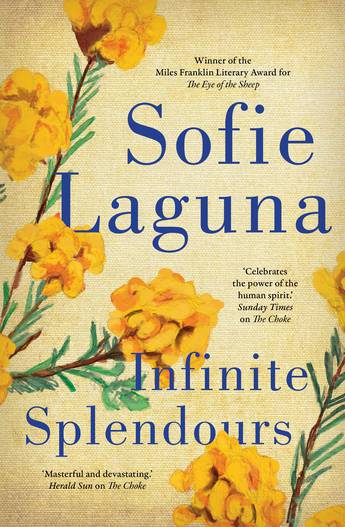Sofie Laguna’s latest novel Infinite Splendours (Allen and Unwin 2020) is a dark and unsettling exploration of the complex dynamics of child abuse or neglect that morphs into a compassionate and infinitely generous examination of such situations from all sides. It is disturbing and uncomfortable reading; with every turn of the page, we fear for one or another of the characters – for what they might do, or for what might be done to them. The narrative is lightened by the lush description of landscape, and the inclusion of art as a form of therapy, hope, salvation and redemption.
The story is narrated by Lawrence Loman as we see him in three stages of his life. We first meet him at age 10; he is a bright and clever boy, a talented scholar and a budding artist interested in drawing and painting. His teacher is encouraging of his potential. It is 1953 in the Grampions in Victoria. Lawrence’s father has died a hero in the war. All that is left to remind his family of his existence is his treasured medal, The Atlantic Star, and the dreams he had for them on the small acreage and country house he adored. Laurence’s mother Louise struggles to survive, working full time and raising her two boys. Laurence’s younger brother, Paul, lacks Laurence’s academic abilities but excels at sports. The two are great friends. Louise’s brother arrives, the boys’ uncle, after a long absence and the children understand that their mother and her brother had a difficult upbringing, although they never speak of the details. Louise adores her brother and he quickly settles into their home and acts as a father-figure to the boys. All of this happens in the shade of the great mountain, Wallis, that is almost a character itself.
But when Lawrence suffers a great act of betrayal from someone close to him, it changes him profoundly. He is scarred in a way from which we fear he may never recover. It alters his personality, his dreams, his idea of himself, and his expectations of the world.
The next chapter in Lawrence’s life is as a young man. He is working at the local dairy where his mother has worked for so many years. He is a loner and somewhat isolated. As he has grown into adulthood, he has still not made sense of what happened years earlier. He cannot change the past, but the question is whether he is doomed to repeat it?
The last third of the book reveals Lawrence as a much older man, still living in the same house, but with many of his loved ones gone. He and his brother Paul are no longer close – Lawrence hates him and loves him with equal measure. Lawrence’s situation and his mental health have deteriorated, exacerbated by his isolation, and Paul attempts to care for him as best he can. Lawrence’s art has become his life, and indeed it is the only thing that gives him meaning.
This is an extremely introspective novel that offers readers a glimpse into Lawrence’s mind as a child and as he grows older. With extreme compassion, Sofie Laguna invites us to walk in his shoes and to experience his many moments of self-doubt, self-loathing, hatred, desire, love, his yearning for connection, the artworks and music that move him, and the natural environment that both embraces him and frightens him. We are asked to look at events from two sides. We are forced to reckon with our own knowledge of what has occurred and how that might impact future events. This is a book of flawed characters, with none of them entirely likeable. Each has their faults; every person has their own complicated background that influences their choices and decisions.
I guarantee that if you read this book, you will come away with an opinion divided from any other reader who has navigated the same story. You may even be divided in your own heart about right and wrong, good and evil. Laguna poses uncomfortable questions that are not easily answered, or even readily contemplated. After pages and pages of tense and frightening possible scenarios, when the resolution finally comes, it is sweetness and sadness, relief and fear, failure and redemption. This is a book about the resilience of the human spirit, written in the author’s famous literary style, full of lush description and peopled with richly explored characters. A moving and tender novel filled with compassion.

